#virginia brissac
Text
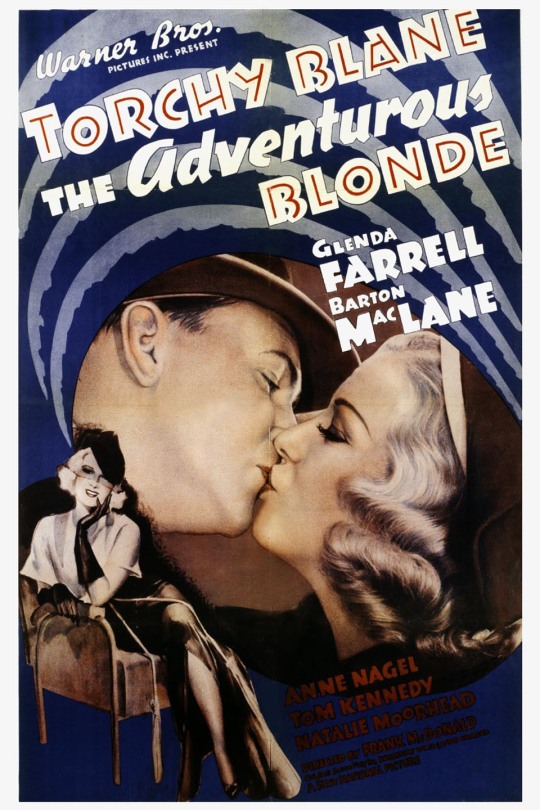
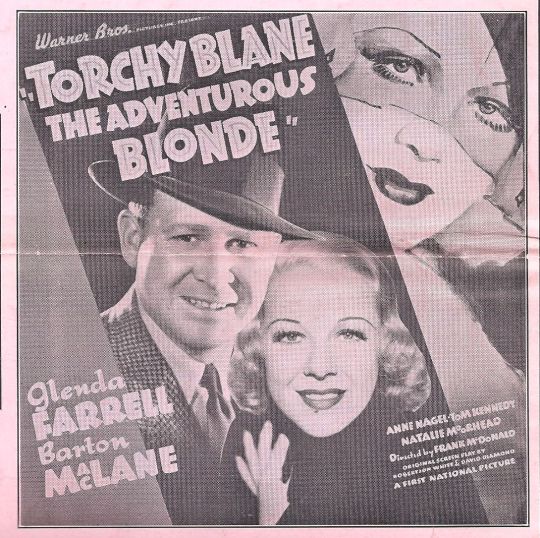


The Adventurous Blonde (1937) Frank McDonald
December 18th 2023
#the adventurous blonde#1937#frank mcdonald#glenda farrell#barton maclane#anne nagel#tom kennedy#natalie moorhead#anderson lawler#charles c. wilson#virginia brissac#carole landis#torchy blane
6 notes
·
View notes
Text

Franchot Tone-Virginia Brissac "La dama desconocida" (The phantom lady) 1944, de Robert Siodmak.
3 notes
·
View notes
Text



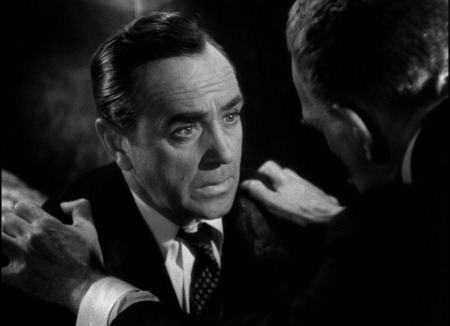

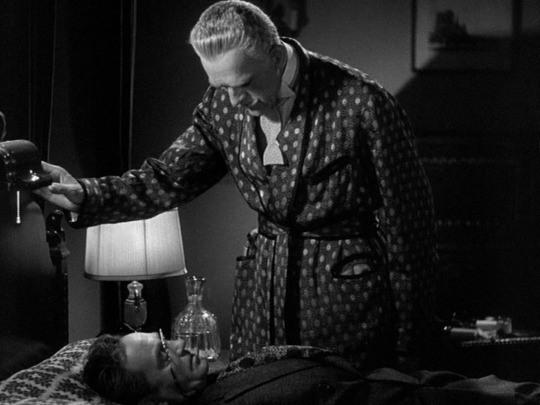




Black Friday (1940)
"Dad... your best friend... oh, you couldn't!"
"I saved his life, didn't I?"
"Well, what's the good of that if you've turned him into a criminal?"
#black friday#american cinema#horror film#1940#mad doctor cycle#i mean it isn't part of the cycle really‚ they were Columbia films‚ but it might as well be; it has an identical set up and format#arthur lubin#curt siodmak#eric taylor#boris karloff#bela lugosi#stanley ridges#anne nagel#anne gwynne#virginia brissac#edmund macdonald#paul fix#raymond bailey#john kelly#murray alper#joe king#fun little nonsense horror that functions as a step sibling to the Mad Doctor Cycle Columbia were concurrently producing with Karloff#but actually he wasn't meant to play the doctor here; supposedly he was cast as the unfortunate subject of the doctor's brain swapping#experiments‚ with Lugosi as the doc. Karloff for whatever reason wanted to play the Doc (possibly he felt he couldn't transform himself#well enough in a physical sense‚ being so distinctive) so Ridges became the victim and Lugosi instead took a lesser role as a crime boss#the result is slightly unsatisfactory for fans of the gruesome twosome; while Ridges walks away with the film (he's genuinely brilliant)#Lugosi is wasted in a bit part and Karloff goes through the motions a little. still there's fun to be had‚ not least in the novel approach#to brain transplants (here the body holds the personality and the brain is just organ‚ whereas it's usually the opposite in the genre)#still it all backfires as it usually does.. Siodmak seems to have had a thing for brain swaps‚ it was a pet passion subject#that he revisited several times (most successfully with 1942 novel Donovan's Brain and its 50s film adaptation)
2 notes
·
View notes
Text
Dread by the Decade: Black Friday
👻 You can support or commission me on Ko-Fi! ❤️

Year: 1940
Genre: Sci-Fi Horror, Crime Thriller
Rating: Approved (Suggested: PG-13)
Country: United States
Language: English
Runtime: 1 hour 10 minutes

Director: Arthur Lubin
Writers: Curt Siodmak, Eric Taylor
Cinematographer: Elwood Bredell
Editor: Philip Cahn
Composers: Hans J. Salter, Frank Skinner
Cast: Boris Karloff, Stanley Ridges, Anne Nagel, Bela Lugosi, Anne Gwynne, Virginia Brissac

Plot: A surgeon replaces part of his injured friend's brain with a gangster's and tries to unlock the dead man's memories.
Review: Despite a rushed ending and uneven character focus, this film's blending of genres and fantastic editing make it well worth a watch.
Overall Rating: 3.5/5

Story: 3.5/5 - It successfully leans on its campy central idea to create genuine tension and intrigue, even if its ending does it a disservice.
Performances: 3.5/5 - Solid, save for Lugosi, who feels a a little miscast. Karloff is especially good as the increasingly unethical Dr. Kovac.
Cinematography: 4/5

Editing: 4.5/5 - Top-notch, especially during the film's rapid montage sequences.
Music: 3/5 - Vacillates between on-point and heavy-handed.
Stunts: 4/5 - The car crash, which was likely completely practical, is excellent.
Sets: 4/5
Costumes, Hair, & Make-Up: 4/5 - Nagel's styling for Sunny is gorgeous.
youtube
Trigger Warnings:
Mild violence
Intimate partner murder
Brief medical scenes
Gaslighting
#Black Friday (1940)#Black Friday#Arthur Lubin#American#sci-fi horror#Dread by the Decade#review#1940s
4 notes
·
View notes
Text




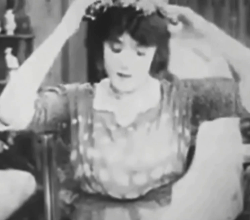




A Submarine Pirate (1915) / Willful Ambrose (1915) / Bombs! (1916) / The Feathered Nest (1916) / Her Torpedoed Love (1917) / Hearts and Flowers (1919) / Down on the Farm (1920)
From her Keystone debut in 1915 to her last First National comedy in 1922, Fazenda was one of Sennett's top comedy stars—appearing in nearly 60 Sennett shorts and features during that time.
Fazenda became familiar audiences as the hayseed girl who was forever falling prey to the shifty city slicker or evil mortgage holder, with her spit curl, ribbon-tied pigtails and calico dress. Just as often, she was the hard-working blue-collar girl who would leave her dreary job as a waitress or maid to collect a healthy inheritance—pursued by the usual assortment of Sennett fortune hunters. With hazel eyes and light brown hair, Fazenda could just as easily put on a blonde wig and play attractive, vampish roles.
Born in Lafayette, Indiana, the daughter of a Mexican-born grocer and American-born mother, Fazenda's family moved to LA by 1900—where she attended Los Angeles High School and St. Mary's Convent. She debuted in dramatic stock with Miss Del Valle in LA and later appeared with Virginia Brissac. Louise got her start in films at Universal in 1912 under the direction of Wilfred Lucas, but by 1913 was appearing alongside Max Asher, Harry McCoy, Bobby Vernon, Gale Henry, Lee Morris, Billy Franey, Heinie Conklin and the other featured players in Universal's Joker Comedies.
When her Sennett contract ended in Sep 1920, Fazenda joined Special Pictures Corp. briefly in late 1920; then she appeared in a trio of California Producers Corp.'s Punch Comedies (1921) co-starring Chester Conklin and John Henry Jr. That came before a brief return to Sennett for a couple of appearances during 1921-22. Fazenda starred in some of Jack White's Mermaid Comedies (1923-24) before settling into roles in features. With the coming of sound, Louise returned to shorts for Christie (1929) and Darmour (1930). She continued with feature support in films. Fazenda found a second home at Warner Brothers, becoming a familiar character face in musicals.
On March 7, 1919, Fazenda married Sennett director Noel M. Smith, to whom she'd been engaged since 1917; they separated on August 14, 1923, and divorced on August 1, 1926. On November 24, 1927 she married Warner Bros. publicity director Hal B. Wallis, soon to became Warners' studio manager and then a long-time film producer. Fazenda retired from the screen in 1939, and remained married to Wallis until her death at 66 in Beverly Hills of a cerebral hemorrhage, leaving Wallis and son Brent. She is interred at Inglewood Park Cemetery, Inglewood, California.
-Walker, B.E., 2010, Mack Sennett's Fun Factory, McFarland&Company, Inc., Publishers, pp. 502~504
#louise fazenda#a submarine pirate 1915#willful ambrose 1915#bombs! 1916#the feathered nest 1916#her torpedoed love 1917#hearts and flowers 1919#down on the farm 1920#책 인용
8 notes
·
View notes
Photo
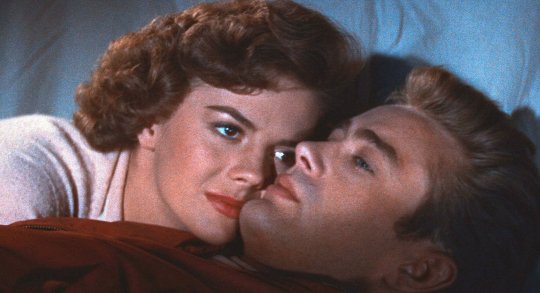
Natalie Wood and James Dean in Rebel Without a Cause (Nicholas Ray, 1955)
Cast: James Dean, Natalie Wood, Sal Mineo, James Backus, Ann Doran, Corey Allen, William Hopper, Rochelle Hudson, Dennis Hopper. Screenplay: Stewart Stern, Irving Shulman, Nicholas Ray. Cinematography: Ernest Haller. Art direction: Malcolm C. Bert. Film editing: William H. Ziegler. Music: Leonard Rosenbaum.
Rebel Without a Cause seems to me a better movie than either of the other two James Dean made: East of Eden (Elia Kazan, 1955) and Giant (George Stevens, 1956). It's less pretentious than the adaptation of John Steinbeck's attempt to retell the story of Cain and Abel in the Salinas Valley, and less bloated than the blockbuster version of Edna Ferber's novel about Texas. And Ray, a director with many personal hangups of his own, was far more in tune with Dean than either Kazan or Stevens, who were shocked by their star's eccentricities. Granted, Rebel is full of hack psychology and sociology, attributing the problems of Jim Stark (Dean), Judy (Natalie Wood), and John "Plato" Crawford (Sal Mineo) to parental inadequacy: Jim's weak father (Jim Backus) and domineering mother (Ann Doran) and paternal grandmother (Virginia Brissac), Judy's distant father (William Hopper) and mother (Rochelle Hudson), and Plato's absentee parents who have left him in care of the maid (Marietta Canty). In fact, Jim and his friends really are rebels without a cause, there being neither an efficient cause -- one that makes them do stupidly self-destructive things -- nor a final cause -- a clear purpose behind their madness. Fortunately, Ray is not as interested in explaining his characters as he is in bringing them to life. Unlike Kazan or Stevens, Ray gives his actors ample room to explore the parts they're playing. There's a loose, improvisatory quality to the scenes Dean, Wood, and Mineo play together, more suggestive of the French New Wave filmmakers than of Hollywood's tightly controlled directors. It's no surprise that both Jean-Luc Godard and François Truffaut were admirers of Ray's work. At the same time, though, Rebel is very much a Hollywood product, with vivid color cinematography by Ernest Haller, who had won an Oscar for his work on Gone With the Wind (Victor Fleming, 1939), and a fine score by Leonard Rosenman. Most of all, though, it has Dean, Wood, and Mineo, performers with an obvious rapport. At one point, for example, Dean puts a cigarette in his mouth backward -- filter on the outside -- and Wood reaches out and turns it around, a bit establishing their intimacy that feels so real that you wonder if it was improvised or developed in performance. (In fact, I noticed the gesture because I had just seen Billy Wilder's The Lost Weekend, made ten years earlier, in which Jane Wyman performs the same turning-the-cigarette-around action for Ray Milland several times. Cigarettes are nasty things but they make wonderful props.)
8 notes
·
View notes
Text
Rebel Without a Cause (1955)
Time to watch one of James Dean’s last films. He died a month before this was released.

The above scene was completely improvised by James Dean. He told the cameras to roll and said, “Just want to try something.” They kept it for the opening credits.





"If I had one day when I didn't have to be all confused and I didn't have to feel that I was ashamed of everything. If I felt that I belonged someplace. You know?”



Why is “the new kid” trope ever something to pick on? I always found the new kid to be the most exciting. There’s always possibility with a new kid.


Buzz Gunderson: You know something? I like you.
Jim Stark: Why do we do this?
Buzz Gunderson: You've gotta do something. Don't you?

God, how terrifying. Poor Buzz. He was a bit of a bully, but he didn’t deserve that.






Why is this child more honorable than his parents?! They want a good kid, but they won’t let the kid be a good kid. They’re awful.
“Jim who? I’VE NEVER HEARD OF YOU!” Hangs up. Seriously? Like, so what? Who cares if you’ve never heard of him. Could be a new friend from school. What a dickhead.

Fun fact: The pool in this film was first used for Sunset Boulevard.





ESE: 90/100
50
+5 for offering a stranger your coat
+5 for mooing at Taurus
+5 for the world ending
-10 for Judy grinning while Buzz stabs Jim’s tire
+5 for Jim’s dad’s flowery apron
+10 for the story of a single day
+5 for the most adorable little brother
+10 for the cautionary tale
+5 for Plato’s two different socks
+10 for talking Plato down
-10 for cops being fucking trash
#Rebel Without a Cause#James Dean#Natalie Wood#Sal Mineo#Jim Backus#Ann Doran#Corey Allen#William Hopper#Rochelle Hudson#Dennis Hopper#Edward Platt#Marietta Canty#Virginia Brissac#Frank Mazzola#Ian Wolfe#Robert Foulk#drama#romance#movie#film#50s films#review#world record
64 notes
·
View notes
Photo

Virginia Brissac and Joan Crawford in
Harriet Craig (1950)
Director: Vincent Sherman
#Virginia Brissac#Joan Crawford#Harriet Craig#1950#Vincent Sherman#Columbia Pictures#American Films#Films made in the 1950s#Black and White Films
5 notes
·
View notes
Text

The Texas Rangers 1936
#the texas rangers#fred macmurray#jack oakie#jean parker#lloyd nolan#edward ellis#benny bartlett#frank shannon#frank cordell#richard carle#jed prouty#fred kohler#george gabby hayes#stanley andrews#irving bacon#kathryn bates#john beck#hank bell#virginia brissac#ray burgess#bobby caldwell#spencer charters#tex phelps#jack montgomery#neal hart#frank ellis#joe dominguez#homer farra#william gillis#harrison greene
22 notes
·
View notes
Text
10.30.19

#watched#film#letterboxd#the mummy's tomb#harold young#lon chaney jr#turhan bey#john hubbard#elyse knox#dick foran#wallace ford#virginia brissac#cliff clark
6 notes
·
View notes
Photo

Joan Leslie and Virginia Brissac - The Hard Way (1943)
13 notes
·
View notes
Photo






Two of a Kind (1951) Henry Levin
November 20th 2021
#two of a kind#1951#henry levin#edmond o'brien#lizabeth scott#alexander knox#terry moore#griff barnett#robert anderson#virginia brissac#lefty farrell
23 notes
·
View notes
Text

Virginia Brissac (San Jose, California, 11/06/1883-Santa Fe, New Mexico, 26/06/1979).
2 notes
·
View notes
Photo

365 Day Movie Challenge (2017) - #20: The Ghost Breakers (1940) - dir. George Marshall
Once you’ve seen a dozen or so Bob Hope movies from the 30s, 40s and 50s, you know what to expect. You know that the plot will probably be silly but that Hope’s charms will save the picture from being too terrible; if the co-star is Paulette Goddard, as was the case here and also in The Cat and the Canary, then the two stars will definitely have good chemistry; the supporting actors (including Richard Carlson, Paul Lukas, Willie Best, Pedro de Cordoba, Virginia Brissac, Noble Johnson, Anthony Quinn and Lloyd Corrigan) will do the best that they can in the screwball comedy proceedings; and with the presence of cinematographer Charles Lang and costume designer Edith Head, everyone and everything will look great. The plot recycles the aforementioned Cat and the Canary’s plot - one character (Goddard) inherits a fortune and a creepy mansion in a spooky locale (here Paramount exchanges the voodoo powers of the Louisiana bayou for the voodoo powers of a tiny island near Cuba) and another character (Hope) helps her stop a greedy relative trying to kill her; the protagonists fall in love in the process - but the studio made one positive change by giving Willie Best, a talented African-American actor, a fairly large role as Hope’s valet, a character who is as smart as, if not occasionally smarter than, his employer.
#365 day movie challenge 2017#the ghost breakers#1940#1940s#40s#george marshall#old hollywood#bob hope#paulette goddard#richard carlson#paul lukas#willie best#pedro de cordoba#virginia brissac#noble johnson#anthony quinn#lloyd corrigan#charles lang#edith head
1 note
·
View note
Text
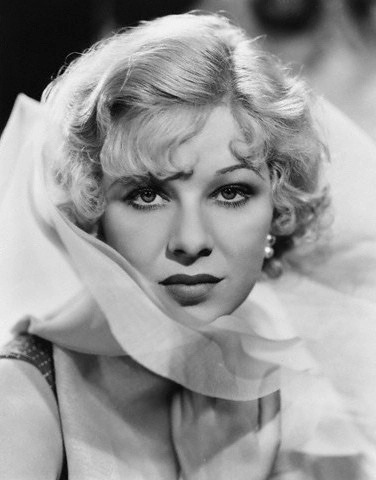
Glenda Farrell (June 30, 1904 – May 1, 1971) was an American actress. With a career spanning more than 50 years, Farrell appeared in over 100 films and television series, as well as numerous Broadway play. She won an Emmy Award in 1963 for Outstanding Supporting Actress for her performance as Martha Morrison in the medical drama television series Ben Casey.
Farrell began acting on stage as a child and continued with various theatre companies and on Broadway before signing with Warner Bros. Embodying the brassy blonde character of the early talkies. Farrell was a signature 1930s Warner Bros. star, starring in films such as Little Caesar (1931), I Am a Fugitive from a Chain Gang (1932), Mystery of the Wax Museum (1933) and Lady for a Day (1933). Starting with Smart Blonde (1937), Farrell played Torchy Blane, the hard-boiled, wisecracking reporter in a series of popular films; which later was credited by comic book writer Jerry Siegel as the inspiration for the DC Comics reporter, Lois Lane. After leaving Warner Bros. in 1939, Farrell remained active in film, television and theatre throughout rest of her career.
Farrell was born in Enid, Oklahoma, to Wilhelmina "Minnie" (nee Messer, 1879-1931) of German descent and Charles A. Farrell (1873-1937) of Irish and Cherokee descent. Farrell was the only daughter and had two younger brothers, Eugene and Richard. After her family moved to Wichita, Kansas, Farrell began acting on stage with a theatrical company at age seven, playing the role of Little Eva in the play Uncle Tom's Cabin. Farrell's mother had never achieved her desire of being an actress, encouraged and supported her daughter's acting interests. When her family moved to San Diego, California, a teenage Farrell joined the Virginia Brissac Stock Company. Farrell made the third honour roll in Motion Picture Magazine's "Fame and Fortune Contest". Her picture and biography were featured in the magazine's April 1919 issue, which also stated that Farrell had some experience in the chorus, vaudeville, and camp entertainments. Farrell received a formal education at the Mount Carmel Catholic Academy.
In 1928, Farrell was cast as the lead actress in the play The Spider and made her film debut in a minor role in Lucky Boy. Farrell moved to New York City in 1929, where she replaced Erin O'Brien-Moore as Marion Hardy in Aurania Rouverol's play Skidding. The play later served as the basis for the Andy Hardy film series. By April 1929, the Brooklyn Daily Eagle reported that she had played the role 355 times. Farrell appeared in a number of other plays, including Divided Honors, Recapture, and Love, Honor and Betray with George Brent, Alice Brady, and Clark Gable.
In 1930, she starred in the comedy short film The Lucky Break with Harry Fox, and in July 1930 Film Daily announced that Farrell had been cast in Mervyn LeRoy's film Little Caesar as the female lead, Olga Stassoff. Afterward, she returned to Broadway and starred in On the Spot at the Forrest Theater. At the time, Farrell conceded that motion pictures offered immense salaries, but felt the theater was the foundation of the actor's profession.[6] She appeared in several more plays.
In 1932, Farrell starred in the hit play Life Begins. Her performance caught the attention of Jack Warner, who signed her to a contract with the Warner Bros. film studio and cast her to recreate the role in Warner Bros.' film adaptation of Life Begins later that year. Farrell did not return to the stage until 1939.
In her first two years with Warner Bros., Farrell starred in 17 films, including Girl Missing (1933), Gambling Ship (1933), Man's Castle (1933) opposite Spencer Tracy, and Columbia Pictures' Lady for a Day (1933) by director Frank Capra. Farrell sometimes would work on three pictures that were shooting at the same time and managed to transition from one role to another effortlessly. She worked in over 20 movies between 1934 and 1936, starring in films such as Go into Your Dance (1935), Little Big Shot (1935) and High Tension (1936).
Farrell was close friends with fellow Warner Bros. actress Joan Blondell,[8] and throughout the early 1930s, they were paired as a comedy duo in a series of five Warner Bros. movies: Havana Widows (1933), Kansas City Princess (1934), Traveling Saleslady (1935), We're in the Money (1935) and Miss Pacific Fleet (1935). She also appeared with Blondell in the Academy Award-nominated Gold Diggers of 1935 and Gold Diggers of 1937 musical film series. Farrell and Blondell co-starred in a total of nine films. Together, they came to personify the smart and sassy, wisecracking dames of '30s and '40s film.
In 1937, Farrell began starring as Torchy Blane, the fast-talking wisecracking newspaper reporter.[9] Warner Bros. had started to develop a film adaptation of "MacBride and Kennedy" stories by detective novelist Frederick Nebel in 1936. For the film version, Kennedy is changed to a woman named Theresa "Torchy" Blane and is in love with MacBride's character. Director Frank MacDonald immediately knew whom he wanted for the role of Torchy Blane. Farrell had already proved that she could play hard-boiled reporters in Mystery of the Wax Museum (1933) and Hi, Nellie! (1934); and was quickly cast as Torchy with Barton MacLane playing detective Steve McBride in the first Torchy Blane film Smart Blonde (1937).
Smart Blonde was a surprise hit and became a popular second feature with moviegoers. Warner Bros. starred her in several more Torchy Blane movies opposite Barton MacLane. She portrayed Torchy in seven films from 1937 to 1939. The films took Farrell's popularity to a new level. She was beloved by the moviegoing public and received a huge amount of fan mail for the films. On her portrayal of the Torchy Blane character, Farrell said in her 1969 Time interview: "So before I undertook to do the first Torchy, I determined to create a real human being—and not an exaggerated comedy type. I met those [news-women] who visited Hollywood and watched them work on visits to New York City. They were generally young, intelligent, refined, and attractive. By making Torchy true to life, I tried to create a character practically unique in movies."
Along with starring in the Torchy Blane series, Farrell appeared in a number of other films, including Breakfast for Two (1937), Hollywood Hotel (1937), and Prison Break (1938). Additionally, she performed in several radio series, including Vanity and Playhouse in 1937, and Manhattan Latin with Humphrey Bogart in 1938.
Farrell was elected to a one-year term as the honorary mayor of North Hollywood in 1937, beating her competition Bing Crosby and Lewis Stone by a three-to-one margin. Even though it began as a Warner Bros. publicity stunt, Farrell took the job seriously, attending functions, presentations, and ceremonies. She was also put in charge when the North Hollywood Chamber of Commerce announced that it wanted to put sewers along Ventura Highway and started the groundwork for that project.
In 1939, Farrell left Warner Bros. when her contract expired. Several factors resulted in her decision including, feeling Warner Bros. was typecasting her as a newspaper reporter, a disagreement by Jack Warner for a pay rise, and wanting to return to the theatre. Farrell later told syndicated columnist Bob Thomas in 1952: "There's something more satisfying about working in a play. You get that immediate response from the audience, and you feel that your performance is your own. In pictures, you get frustrated because you feel you have no power over what you're doing".
In July 1939, Farrell starred in the lead role in the play Anna Christie at the Westport Country Playhouse, then followed that with a summer stock production of S. N. Behrman's play Brief Moment. She co-starred with Lyle Talbot and Alan Dinehart in the long-running play Separate Rooms at Broadway's Plymouth Theater for a successful 613-performance run throughout 1940 and 1941. In April 1942, she starred in the Broadway play, The Life of Reilly.
Farrell returned to motion pictures in 1941, starring in director Mervyn LeRoy's film noir, Johnny Eager. Throughout the '40s, '50s, and '60s, Farrell continued to appear in numerous films, including the Academy Award-nominated The Talk of the Town (1942), Heading for Heaven (1947) and the 1954 Charlton Heston adventure epic Secret of the Incas.
Farrell made her television debut in 1949 in the anthology series The Chevrolet Tele-Theatre. She appeared in over 40 television series between 1950 and 1969, including Kraft Theatre, Studio One in Hollywood, The United States Steel Hour, Bonanza, and Bewitched.
In 1963, she guest-starred in the ABC medical drama series Ben Casey as Martha Morrison in the two-part episode "A Cardinal Act of Mercy". She won the Primetime Emmy Award for outstanding performance in a supporting role by an actress. Farrell co-starred with her son Tommy Farrell in two comedy films in 1964: Kissin' Cousins with Elvis Presley and Jerry Lewis in The Disorderly Orderly.
Farrell briefly retired in 1968, but soon decided to return to acting. Farrell's final work in her long career was the Broadway play Forty Carats. She was appearing in Forty Carats at the Morosco Theatre until ill health forced her to leave the play a few months later. Farrell was eventually diagnosed with lung cancer.
In 1920, Farrell was hired to do a dance routine at a Navy benefit ball in San Diego. There she met her first husband, Thomas Richards. They were married from 1921 to 1929. Their son, actor Tommy Farrell, was born in 1921. In 1931, she was engaged to Jack Durant of the comedy duo "Mitchell and Durant" but never married him. She dated screenwriter Robert Riskin a few years later.
In 1941, Farrell married Dr. Henry Ross. The couple met when Farrell sprained her ankle during a performance of the play Separate Rooms and was treated backstage by Ross, who had been called forth from the audience. Ross was a staff surgeon at New York's Polyclinic Hospital and West Point graduate, who later served as chief of the public health section on General Eisenhower's staff. Farrell and Ross remained married until her death 30 years later. Farrell was a devout Catholic.
In 1971, Farrell died from lung cancer, aged 66, at her home in New York City and was interred in the West Point Cemetery in West Point, New York. When Ross, who did not remarry, died in 1991, he was buried with her.
Comic book writer Jerry Siegel credits Farrell's portrayal of Torchy Blane as the inspiration for the fictional Daily Planet reporter and Superman's love interest, Lois Lane. Siegel also named June Farrell, one of the characters in his Funnyman comic book series, after Farrell.
On February 8, 1960, Farrell received a star on the Hollywood Walk of Fame for her contribution to motion pictures, at 6524 Hollywood Boulevard.
In 1977, Farrell's husband Dr. Henry Ross donated 38 acres of land to the Putnam County Land Trust, establishing the Glenda Farrell–Henry Ross Preserve.
#glenda farrell#classic hollywood#classic movie stars#golden age of hollywood#old hollywood#1920s hollywood#1930s hollywood#1940s hollywood#1950s hollywood#1960s hollywood#1970s hollywood#hollywood legend
18 notes
·
View notes
Photo

Mickey Rooney and Judy Garland in Strike Up the Band (Busby Berkeley, 1940)
Cast: Mickey Rooney, Judy Garland, Paul Whiteman, June Preisser, William Tracy, Larry Nunn, Ann Shoemaker, Margaret Early, Francis Pierlot, Virginia Brissac, George Lessey, Enid Bennett, Howard Hickman, Sarah Edwards, Milton Kibbee, Helen Jerome Eddy. Screenplay: John Monks Jr., Fred F. Finkelhoffe. Cinematography: Ray June. Art direction: Cedric Gibbons, John S. Detlie. Film editing: Ben Lewis. Music: Leo Arnau, George Stoll.
At one point in Strike Up the Band, the kids put on a show that's a burlesque of a "Gay Nineties" melodrama. Which might remind us that 1890 and 1940 were not so remote from each other as 2022 is from 1940. We might even look at a film like High School Musical (Kenny Ortega, 2006) or a TV series like Glee (2009-2015) as a burlesque of Strike Up the Band, except they took the subject matter more seriously than the kids in the 1940 movie did the material of old-time melodrama. Strike Up the Band is a still-honored subgenre, the "hey, kids, let's put on a show" musical. It has all the caricaturable excesses of its kind: big musical numbers that would never fit on an actual stage; the struggle to raise money for the show; the setback when one kid gets sick; the protagonist struggling with whether to become a musician or a physician; the teen romance that isn't quite gelling; the kindly, understanding mother; and even a rousing finale that actually waves the flag. Unfortunately, it's also something of a dud, especially considering the talent involved: Mickey Rooney, Judy Garland, and direction by Busby Berkeley. But this is the Berkeley of the MGM years, not the unfettered "choreographer of space" of the Warner Bros. musicals of the early 1930s -- or even the Berkeley who snuck over to 20th Century Fox in 1943 and gave Carmen Miranda a tutti-frutti hat in one of the craziest moments in The Gang's All Here. At MGM he was reined in too much, though you can sense him yearning to break free in numbers like the title sequence and "Do the La Conga." Garland sings some mostly unmemorable songs well -- though MGM bought the rights to the 1927 stage musical by George and Ira Gershwin, it retained only the title song; the rest are by Roger Edens and the film's producer, Arthur Freed, along with some period oldies for the melodrama sequence. And Rooney is as manic as he ever got on film: dancing, mugging, and frenetically playing the drums. Still, at 120 minutes, Strike Up the Band sags a little too often, especially in a stop-motion puppetry sequence in which Rooney imagines conducting an orchestra made up of fruit -- an idea that Vincente Minnelli came up with and producer Freed enthusiastically adapted. Better songs and a brighter supporting cast might have helped, and the 40-year-old hairlines on some of the supposed high school students are too much in evidence.
2 notes
·
View notes